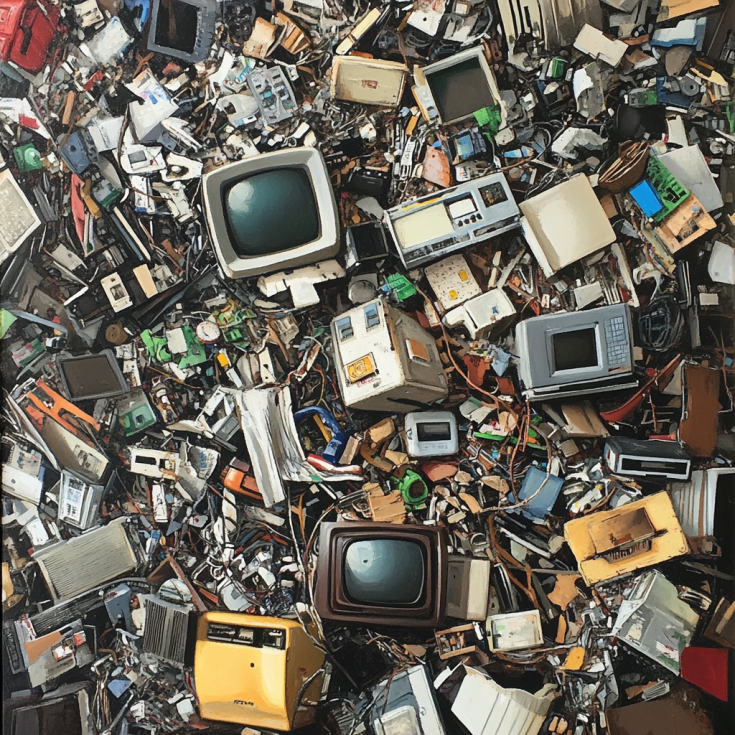Tackling the electrical and electronic waste challenge

The world is experiencing significant electrification and digitalisation, and as a result people’s homes are increasingly filled with electronic devices. Electrical and electronic equipment waste (WEEE) is among the fastest-growing waste streams. A record 62 million tonnes (Mt) of e-waste was produced in 2022, up 82% from 2010.
And according to the United Nations‘ Global E-waste Monitor, it is expected to rise another 32%, to 82 million tonnes, in 2030. This waste stream comprises a complex mixture of materials, including hazardous content, requiring specific management to avoid major environmental and health damage, or high-value and critical raw materials. For example, around 10% of gold worldwide produces modern electronics.
Electrical and Electronic Equipment Waste - European perspective
Collection rates in the EU Member states have not yet reached these targets, with collection being still rather low, around 45%. When collected, the recycling rates reach around 80%. Discarding WEEE materials also translates to significant financial losses for the European economy. It is estimated that the overall potential revenues from WEEE recycling in the EU could amount to € 2.15–3.67 billion (2020). Re-use of WEEE is more environmentally friendly than recycling, saving 1,14 tonnes of CO2 per tonne, compared to 0,85 tonnes, and has a significant job creation potential. Preparation for the re-use of WEEE creates between 60 and 140 jobs per 1,000 tonnes.
On the EU policy level, several important legislations aim to improve the current situation. The EU WEEE Directive has set the target of a 65% minimum collection rate, the Circular Economy Action Plan has presented ideas of EU-wide take back/sell back schemes and a review of hazardous substances used in electronic equipment, and the Eco-design Directive calls for reparability and durability of electronic items. Very important is the newly approved European Right to Repair Directive, which requires sellers to repair products, and should generally make repairs cheaper and easier.
Solutions for better e-waste management
To improve our electronic waste footprint, there are many aspects to tackle, from designing to last longer, to collection, reuse, repair and recycling. The Interreg Europe WEEEWaste project explores implementation of better approaches for the management of electrical and electronic waste equipment – with a number of good practices already in use.
Education and awareness-raising are important in achieving higher waste prevention rates. The Spanish region of Navarra has been able to garner over eight million views of their 'In Navarra we love recycling!' videos.
The awareness campaign promotes recycling among citizens in thematic campaigns, including those related to WEEE recycling and circular economy. One of the objectives of the Waste Plan of Navarra 2017–2027 is to increase recycling, reaching 75% of domestic and commercial waste in 2027.
The city of Gdansk, Poland, has worked up a comprehensive educational project for elementary school students. Apart from education, the city has listened to the needs of local citizens, who requested an easier means of disposing of their electronic waste. The Municipality has installed red containers, easily accessible to residents, which are used for the collection of small-sized electro-waste, up to 50 cm in size.
Reuse and repair are no less important and always preferable to recycling. A reuse center in Slovenia deploys a number of initiatives to reduce e-waste:
- The center focuses on refurbishing and repairing various electronic devices, such as computers, phones, and TVs. Refurbished devices undergo quality testing to ensure functionality.
- The center also conducts awareness-raising campaigns concerning proper electronic waste management and the value of reuse. Reusing devices reduces the need for new products, thereby lowering resource consumption, energy use, and CO2 emissions associated with manufacturing. Simultaneously, the resale of these devices makes them affordable and more accessible to a broader population, particularly benefiting vulnerable groups.
With over five thousand refurbished devices annually, the Reuse Center at CPU Slovenia reduces the environmental footprint of electronic waste through efficient refurbishment and reuse processes.
All of the examples will help establish better electronic waste management and can contribute to circular economy targets related to prevention, reuse, and recycling.
Further resources
For more inspiration, explore the Policy Learning Platform resources related to the topic:
- Policy brief on Reuse and repair in a circular and social economy
- Online workshop recording on Reuse and repair in a circular and social economy
- Webinar recording on Collection and recycling of WEEE
- Story on Reuse and repair centres
- Story on Socially minded platform for the reuse and recycling of Electrical and Electronic Equipment (EEE)
- Story on a New life for prisoners and valuable resources: the WEEE recovery facility
